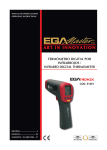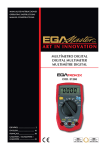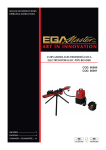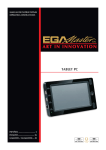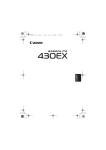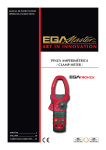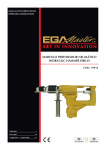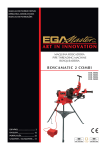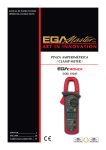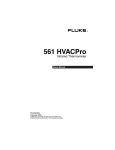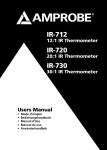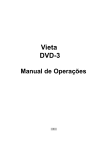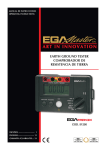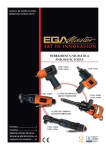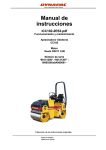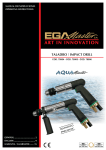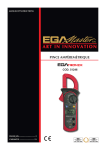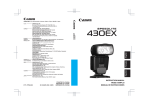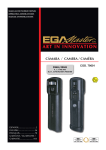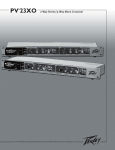Download TERMÓMETRO DIGITAL POR INFRARROJOS
Transcript
MANUAL DE INSTRUCCIONES OPERATING INSTRUCTIONS TERMÓMETRO DIGITAL POR INFRARROJOS / INFRARED DIGITAL THERMOMETER COD. 51262 ESPAÑOL................................ 2 ENGLISH............................... 20 GARANTIA / GUARANTEE.... 39 ESPAÑOL TABLA DE CONTENIDO Introducción.....................................................................................................................................3 Información de seguridad.................................................................................................................4 Características...................................................................................................................................5 Pantalla.............................................................................................................................................5 Botones y conectores........................................................................................................................6 Cómo trabaja el Termómetro............................................................................................................7 Funcionamiento del Termómetro......................................................................................................7 Localización de foco caliente o foco frío...........................................................................................8 Distancia y tamaño del foco..............................................................................................................8 Campo de visión...............................................................................................................................8 Emisividad........................................................................................................................................9 Configuración de usuario..................................................................................................................9 Configuración de emisividad............................................................................................................9 Bloqueo del gatillo.........................................................................................................................11 Selección ºC/ºF...............................................................................................................................11 Configuración HAL.........................................................................................................................12 Configuración LAL..........................................................................................................................12 Datos..............................................................................................................................................12 Medición Termopar tipo K..............................................................................................................12 Retención.......................................................................................................................................13 Mediciones típicas..........................................................................................................................13 Prueba de contactores (arrancadores)..............................................................................................13 Prueba de relés cerrados.................................................................................................................13 Prueba de fusibles y conexiones.....................................................................................................14 Prueba de conexiones eléctricas.....................................................................................................14 Exploración de paredes por pérdidas de aire o deficiencias del aislamiento....................................14 Prueba de cojinetes........................................................................................................................15 Prueba de correas y poleas.............................................................................................................15 Comprobación calor radiante..........................................................................................................16 Medición de temperatura de descarga de rejilla, caja o difusor.......................................................16 Comprobación de obstrucción de aire-aire en los evaporadores o condensadores...........................16 2 Mantenimiento...............................................................................................................................17 Cambio de la batería.......................................................................................................................17 Limpieza de la lente.......................................................................................................................17 Limpieza de la carcasa....................................................................................................................17 Solución de problemas...................................................................................................................17 Certificado CE.................................................................................................................................17 Especificaciones..............................................................................................................................18 Infrarrojos.......................................................................................................................................18 Láser...............................................................................................................................................18 Eléctrico.........................................................................................................................................18 Físico..............................................................................................................................................18 Ambiente........................................................................................................................................18 LISTADO DE TABLAS Símbolos...........................................................................................................................................4 Botones y Conectores.......................................................................................................................7 Emisividad de la superficie................................................................................................................9 Solución de problemas...................................................................................................................17 LISTADO DE FIGURAS Símbolos y marcas de seguridad.......................................................................................................4 Termómetro infrarrojos.....................................................................................................................5 Pantalla del Termómetro...................................................................................................................6 Botones y Conectores.......................................................................................................................6 Localización del foco caliente...........................................................................................................8 Distancia y tamaño del foco..............................................................................................................8 Campo de visión...............................................................................................................................8 INTRODUCCION El termómetro por infrarrojos modelo COD. 51262 (de ahora en adelante, el “Termómetro”) puede determinar la temperatura de una superficie, midiendo la cantidad de energía infrarroja irradiada por la superficie del objetivo. Dispone de diferentes distancias para enfocar (D:S) el objeto y diferentes rangos de temperatura, para más detalles ver contenido. Los termómetros por infrarrojos no necesitan contacto para tomar medidas de temperatura. Cuentan con un diseño de bajo consumo para que puedan ser utilizados por un periodo de tiempo más largo, solventando así la problemática del frecuente cambio de baterías y los problemas de baja batería durante la medición. El diseño inteligente puede tomar medidas de manera más fácil y rápida. El termómetro por infrarrojos, de forma inteligente, puede seleccionar la batería o USB como fuente de energía. 3 INFORMACION DE SEGURIDAD Advertencia! Una advertencia identifica condiciones y acciones que representen un peligro para el usuario. Para evitar descargas eléctricas o daños personales, siga las siguientes instrucciones: No apunte con el láser directamente a los ojos o indirectamente a superficies reflectantes. - Antes del uso del Termómetro, inspeccione la carcasa. No use el Termómetro si ésta parece dañada. Busque roturas o pérdidas de plástico. - Reemplace la batería tan pronto como el indicador de batería aparezca. - No utilice el Termómetro si opera de manera anormal. La protección puede estar dañada. En caso de duda, el Termómetro debe ser reparado. - No utilice el Termómetro alrededor de gas explosivo, vapor, o polvo. Para evitar quemaduras, recuerde que los objetos altamente reflectantes pueden dar lugar a mediciones inferiores a su temperatura real. - No lo use de una manera no especificada por este manual o la protección suministrada por el equipo podrá verse afectada. Precaución. Para evitar daños al termómetro o al equipo bajo prueba protéjalos de lo siguiente: - EMF (campos electromagnéticos) de soldaduras por arco, calentadores de inducción, etc. - Electricidad estática. - Cambios bruscos de temperatura (causados por largos o abruptos cambios de temperatura en el ambiente-espere 30 minutos completos hasta que se estabilice el Termómetro antes de usarlo). - No deje el Termómetro en o cerca de objetos de alta temperatura. Tabla 1 y figura 1. Muestra varios símbolos y marcas de seguridad que están en el Termómetro y en este manual. Tabla 1. Símbolos Símbolo Explicación del símbolo Riesgo de peligro. Información importante. Lea el manual. Advertencia. Láser. Conforme con los estándares de la Unión Europea Batería Figura 1. Símbolos y marcas de seguridad 4 CARACTERISTICAS El Termómetro incluye: - Un sólo punto de mira láser - Fuente de energía inteligente USB - Pantalla retroiluminada - Dos niveles de color blanco de la pantalla retroiluminada (cuando esté cargando por USB, ésta característica se activará automáticamente) - Temperatura actual Plus MIN, MAX, DIF, MED Muestra de temperatura - Sencillo selector de emisividad. - Bloqueo de gatillo - Temperatura seleccionable en grados Celsius y Fahrenheit - Soporte para trípode - Una batería de 9V Pantalla Láser Gatillo Tapa de la batería Batería 9V 6F22 Figura 2. Termómetro Infrarrojos PANTALLA El indicador de temperatura principal informa de la temperatura actual o de la última temperatura IR leída hasta que transcurran 8 segundos de espera. El indicador de temperatura secundario informa de una opción de máximo, mínimo, diferencia entre máximo y mínimo o valor medio de la temperatura. Puede alternar entre los valores máximo, mínimo, diferencia y valor medio de temperatura IR en cualquier momento en la pantalla presionando el botón amarillo. Las temperaturas MAX, MIN, DIF y AV son constantemente calculadas y actualizadas cuando el gatillo es presionado. Después de liberar el gatillo, las temperaturas MX,MIN,DIF y AV son mantenidas hasta que el Termómetro se apague. Notas: Cuando la batería este baja, aparecerá en la pantalla. La última selección (MAX/MIN/DIF/ AVG) es mantenida en el indicador secundario incluso después de que el Termómetro haya sido apagado, siempre que las baterías no hayan fallado. 5 Símbolo Láser “On” HOLD SCAN ºCºF A B C D Explorar o Retener ºC/ºF Símbolo (Celsius/Fahrenheit) Indicador de temperatura principal Indicador de temperatura secundario Emisividad baja, media, alta Valores de temperatura para MAX, MIN, DIF, MED Símbolo de batería baja aparece cuando la carga de batería es <4.5V. Figura 3. Pantalla del Termómetro. BOTONES Y CONECTORES Figura 4. Botones y conectores 6 Tabla2. Botones y conectores Botón / Conector Botón AMARILLO SET Descripción Presione botón AMARILLO para alternar entre MAX, MIN, DIF, MED, HAL, LAL, DATA nad ºT-ºC. Presione botón AMARILLO para encender nuevamente el Termómetro y mostrar el resultado de la ultima medición Presione para entrar en modo configuración. Para detalles consulte apartado configuración de usuario. Presione para encender la retroiluminación de la pantalla, nivel uno de retroiluminación, nivel dos de retroiluminación y apagado de la retroiluminación, el icono aparecerá y desaparecerá. Presione DATA TC-K jack POWER jack USB para encender y apagar el láser. después de que el láser se encienda, será mostrado. Botón de transferencia de datos . Detalles en apartado configuración de usuario. Cuando el Termómetro entre en modo configuración, pulse para seleccionar una opción. Detalles en apartado configuración de usuario. Cuando el Termómetro entre en modo configuración, pulse para seleccionar una opción. Detalles en apartado configuración de usuario Inserte el termopar tipo K en esta entrada para tomar medidas de temperatura con contacto. Inserte el adaptador de corriente en esta entrada. Después de conectar el cable USB, automáticamente el Termómetro selecciona alimentación por USB y la pantalla retroiluminada se encenderán. Con el software instalado, puede llevar a cabo la transeferencia y tratado de datos. COMO TRABAJA EL TERMOMETRO El termómetro infrarrojos toma la medida de temperatura de la superficie de un objeto opaco. La óptica del termómetro detecta la energía infrarroja, que es conectada y enfocada a un detector. Entonces la electrónica del Termómetro traduce la información en un lector de temperatura mostrándolo en la pantalla. El único fin del láser es de apuntar al objeto a medir. FUNCIONAMIENTO DEL TERMOMETRO El Termómetro se enciende cuando presiona el gatillo. El termómetro se apaga cuando no se detecta actividad durante 8 segundos. Para medir temperatura, apunte con el Termómetro al objeto, presione y mantenga el gatillo. Libere el gatillo para mantener la lectura de temperatura. Asegúrese de considerar la relación tamaño distancia al foco y campo de visión. El láser sólo es usado para apuntar. 7 LOCALIZACION DE FOCO CALIENTE O FOCO FRIO Para hallar un foco caliente o frío, apunte el Termómetro fuera del área objetivo. Luego, lentamente atraviese el área con movimientos de arriba abajo hasta localizar el foco caliente o frío. Vea figura 5. Figura 5. Localización de foco caliente o foco frío DISTANCIA Y TAMAÑO DEL FOCO A medida que la distancia (D) del objetivo incremente, el tamaño (S) del área del foco medido por la unidad aumentará. El tamaño del foco indica el 90% de la energía cercada. CAMPO DE VISION Asegúrese de que el objetivo es más grande que el tamaño del foco. Cuanto menor sea el objetivo, más cerca debería estar. Vea figura 7. No Si Figura 7. Campo de visión 8 EMISIVIDAD La emisividad describe las características de emisión de energía de los materiales. La mayor parte de las superficies de los materiales y pinturas u óxidos tienen una emisividad en torno a 0.95. Si es posible, para compensar las lecturas erróneas que pueden derivarse de la medición de superficies de metales brillantes, cubra la superficie a medir con cinta adhesiva o pintura mate negra (<150ºC/302ºF) y utilizar el ajuste de emisividad alto. Deje tiempo para que la cinta o la pintura alcance la misma temperatura que la superficie debajo. Mida la temperatura de la superficie de la cinta o pintura. Si no puede usar cinta o pintura, puede mejorar la precisión de sus mediciones con el selector de emisividad. A pesar del selector de emisividad, puede existir dificultad de conseguir una precisión completa de la medición del objetivo con una superficie metálica o brillante. CONFIGURACION DE USUARIO Presione botón SET para pasar a través de configuración de emisividad, bloqueo de gatillo, o selección ºC/ºF. Presione botón AMARILLO para seleccionar y salir. CONFIGURACION DE EMISIVIDAD Esta característica es para cambiar el valor de emisividad. Para ajustar este valor, siga el siguiente procedimiento:. 1. Presione SET para seleccionar emisividad. El icono E parpadeará. 2.Presione para aumentar el valor de 0.01 o presione y mantenga para acceder a configuración rápida. El máximo valor es 1.00. 3.Presione para reducir el valor o presione y mantenga para acceder a configuración rápida. El valor mínimo es 0.10. El Termómetro le permite ajustar la unidad de emisividad para el tipo de superficie antes de medir. Remitir a tabla 2. Pero solamente es un caso de referencia. Puede basarse en su propio caso y materiales para tener diferentes configuraciones. Tabla 3. Emisividad de la superficie Superficie Valor de cambio METALES Aluminio Oxidado Aleación A3003 Oxidado Rugoso 0.2-0.4 0.3 0.1-0.3 Latón Bruñido Oxidado 0.3 0.5 9 Cobre Oxidado Bloques de terminales eléctricos 0.4-0.8 0.6 Haynes Aleación 0.3-0.8 Inconel Oxidado Chorro de arena Electropulido 0.7-0.95 0.3-0.6 0.15 Hierro fundido Oxidado Sin oxidar Fundido 0.6-0.95 0.2 0.2-0.3 Hierro forjado Mate 0.9 Conductor Áspero Oxidado 0.4 0.2-0.6 Molibdeno Oxidado 0.2-0.6 Niquel Oxidado 0.2-0.5 Platino Negro 0.9 Acero Laminado en frío 0.7-0.9 Hierro Oxidado Enmohecido 0.5-0.9 0.5-0.7 NO-METALES Amianto 0.95 Asfalto 0.95 Basalto 0.7 Carbón Sin oxidar Grafito 0.8-0.9 0.7-0.8 Carborundo 0.9 Cerámica 0.95 10 Arcilla 0.95 Tela 0.95 Ground Sheet Polished Sheet 0.4-0.6 0.1 Zinc Oxidado 0.1 Vídrio Plata 0.85 Grava 0.95 Yeso 0.8-0.95 Hielo 0.98 Piedra caliza 0.98 Papel (cualquier color) 0.95 Plástico Opaco 0.95 Tierra 0.9-0.98 Agua 0.93 Madera (natural) 0.9-0.95 BLOQUEO DEL GATILLO Para bloquear o desbloquear el gatillo, proceda de la siguiente manera: 1. Presione SET para seleccionar bloqueo de gatillo, el icono parpadeará. 2. Presione o para seleccionar apagado o encendido. Cuando el gatillo esté bloqueado, el Termómetro quedará encendido para continuar midiendo, no es necesario pulsar el gatillo. Cuando el gatillo esté desbloqueado, es necesario que pulse el gatillo para medir. Cuando libere el gatillo, el Termómetro mantendrá el resultado de la medida automáticamente. SELECCIONAR ºC/ºF Esta característica permite la selección entre ºC o ºF. 1. Presione SET para elegir modo selección ºC/ºF. 2. Presione o para seleccionar ºC o ºF. 11 CONFIGURACION HAL Esta característica sirve para configurar el límite máximo de temperatura. El Termómetro sonará si el valor medido es superior al máximo configurado. 1.Presione botón AMARILLO para sellecionar modo HAL. 2.Presione para incrementar el valor o presione y mantenga para incrementarlo rápidamente hasta el máximo valor de temperatura deseado. El Termómetro para y suena. 3.Presione para decrementar el valor o presione y mantenga para decrementarlo rápidamente hasta el mínimo valor de temperatura deseado o hasta el mínimo valor LAL. El Termómetro para y suena. 4.Presione SET para confirmar esta configuración mostrando en la pantalla HIGH. 5. Esta característica no es válida cuando se lleven a cabo medidas con el modo termopar tipo K. 6. El valor HAL no puede ser configurado por debajo del valor LAL. CONFIGURACION LAL Esta característica es para configurar el límite mínimo de temperatura. El Termómetro sonará si el valor medido es superior al máximo configurado. 1.Presione botón AMARILLO para sellecionar modo LAL. 2.Presione para incrementar el valor o presione y mantenga para incrementarlo rápidamente hasta el máximo valor de temperatura deseado o hasta el máximo valor HAL. El Termómetro para y suena. 3.Presione para decrementar el valor o presione y mantenga para decrementarlo rápidamente hasta el mínimo valor de temperatura deseado.El Termómetro para y suena. 4.Presione SET para confirmar esta configuración siendo mostrada en la pantalla LOW, 5. Esta característica no es válida cuando se lleven a cabo medidas con el modo termopar tipo K. 6. El valor LAL no puede ser configurado por encima del valor HAL. DATOS Esta característica sirve para almacenar los datos recogidos en modo medición. 1. El máximo número de datos a ser almacenados es 99. 2. Cuando la memoria esté vacía se mostrará ‘--- . ---’ 3. Bajo modo no medición, presione y mantenga DATA y durante 8 segundos para eliminar los datos de la memoria, el termómetro sonará. 4. Bajo modo medición, presione botón AMARILLO para cambiar a modo DATA. 5. Presione o para seleccionar la localización de los datos almacenados. 6. Presione DATA para almacenar el valor. MEDICION TERMOPAR TIPO K Esta característica sirve para medir la temperatura con termopar tipo K. 1. Presione botón AMARILLO para acceder a modo ºT-ºC. La pantalla mostrará OL antes de que el termopar se desconecte. 2. Conecte el termopar tipo k, presione el gatillo y comience la medición. La pantalla mostrará la lectura. 3. Libere el gatillo. La lectura será mantenida y la pantalla mostrará ºT-ºC. La temperatura medida es mostrada en la parte inferior derecha. 12 RETENCION La pantalla se mantendrá activada 8 segundos después de liberar el gatillo. HOLD aparece en la mitad superior de la pantalla. Cuando el gatillo se pulse de nuevo, el Termómetro comenzará a medir con la última función seleccionada. MEDICIONES TIPICAS Esta sección describe una variedad de mediciones realizadas a menudo por los técnicos. Recordatorio: - El usuario puede seleccionar apagar o encender la retroiluminación y apagar o encender el láser donde sean tomadas las lecturas con el Termómetro. Pero si se está utilizando el USB como medio de alimentación, los dos niveles de retroiluminación se encenderán automáticamente. - Emisividad relativamente alta significa normalmente ajuste de emisividad de alrededor de 0.95. - Emisividad relativamente baja significa normalmente ajuste de emisividad de alrededor de 0.30. - Cuando el usuario no pueda identificar la emisividad del objeto a medir, el usuario puede cubrir la superfice a medir (temperatura>150ºC) con una cinta eléctrica negra (emisividad de alrededor de 0.95). De tiempo a la cinta para que alcance la misma temperatura que la del objeto a medir. Mida y registre la temperatura de la cinta. - Apunte con el Termómetro hacia el objeto a medir, ajuste la emisividad para que sea la misma que la temperatura de la cinta. En este momento, el ajuste de la emisividad del termómetro está cerca de la emisividad del objeto a ser medido, la medición puede comenzar. PRUEBA DE CONTACTORES (ARRANCADORES) 1.Presione SET para seleccionar emisividad. Presione / para seleccionar emisividad relativamente baja para contactos brillantes, o 0.7 de nivel medio para contactos oscuros. 2.Presione AMARILLO para seleccionar MAX. 3.Mida la línea y carga lateral de un polo sin liberar el gatillo. 4.Una diferencia de temperatura entre la línea y la carga lateral de un polo indica un incremento de la resistencia de un punto y el contacto puede estar fallando. PRUEBA DE RELES CERRADOS 1.Presione SET y luego / para ajustar la emisividad a relativamente baja para conectores sin aislamiento o relativamente alta para relés recubiertos de plástico o para relés cerrados de baquelita o conectores aislados. 2.Presione botón AMARILLO para seleccionar MAX. 3.Inicie la búsqueda 4.Mida la carcasa del relé en busca de focos calientes. 5.Mida las conexiones eléctricas en los terminales del relé en busca de focos calientes. 13 PRUEBA DE FUSIBLES Y CONEXIONES 1.Presione SET y luego presione para configurar emisividad a relativamente alta para el cuerpo del fusible cubierto de papel o conectores aislados. 2.Presione botón AMARILLO para seleccionar MAX. 3.Busque a lo largo de la cubierta del papel del fusible. 4.Sin liberar el gatillo, busque cada fusible. Temperaturas desiguales entre fusibles pueden indicar desequilibrio de intensidad o amperaje. 5.Presione SET y luego / para ajustar la emisividad a relativamente baja, para fusibles de metal y tapas y conexiones aisladas. 6.Presione MODE para seleccionar MAX. 7.Busque el extremo de cada tapa en cada fusible. Nota: Temperaturas desiguales o una temperatura alta indica una conexión floja o corroída a través de la abrazadera del fusible. PRUEBA DE CONEXIONES ELECTRICAS 1. Presione SET y luego / para ajustar la emisividad a relativamente baja para conectores sin aislamiento o conexiones buss o relativamente alta para conexiones aisladas. Nota: Usualmente los conductores son más pequeños que el tamaño del foco del Termómetro. Si el tamaño del foco es mayor que el conector, la lectura de temperatura es la media de la del foco. 2. Busque el conductor, moviendo hacia la dirección del conector eléctrico (conexión rápida, tuerca para cable, conexión buss, o agarradera). EXPLORACION DE PAREDES POR PERDIDAS DE AIRE O DEFICIENCIAS DEL AISLAMIENTO 1. Apague la calefacción, enfriadores o aireadores 2.Presione SET para seleccionar emisividad. Presione / para seleccionar emisividad relativamente alta para superficies pintadas o superficies de ventanas. 3. Presione botón AMARILLO para seleccionar MIN cuando el lado opuesto de la pared está a menor temperatura y/o seleccione MAX cuando el lado opuesto de la pared esté a mayor temperatura. 4. Mida la temperatura de la superficie interior de la pared. No libere el gatillo. Registre la temperatura como su base (o punto de referencia) para paredes “perfectamente” aisladas. 5. Póngase en frente de la pared a escanear. Escaneela. 6. Analice con líneas horizontales desde la parte superior hasta la inferior, o en líneas horizontales del techo de pared a pared. Busque las mayores desviaciones de temperatura como referencia para identificar los problemas. Esto completa el análisis del aislamiento. Encienda el aireador (no calor, no enfriador) y compruebe de nuevo. Si los resultados del test con el aireador activado son diferentes que con el aireador desactivado, esto puede indicar 14 fugas de aire en las paredes acondicionadas. Las pérdidas de aire son causadas por fugas en los conductos que crea una presión diferencial a través del espacio acondicionado. PRUEBA DE COJINETES Advertencia! Para evitar daños probando cojinetes: -No lleve ropas amplias, joyas, o cualquier otra cosa alrededor del cuello cuando trabaje sobre elementos de movimiento tales como motores, aireadores, correas y ventiladores. -Asegúrese de que la desconexión eléctrica está al alcance, libre y operando correctamente. -No trabaje sólo. Nota: Funciona mejor comparar dos motores similares que operan con cargas similares. 1.Presione SET y luego / para seleccionar emisividad relativamente alta. 2.Presione botón AMARILLO para seleccionar MAX. 3.Active el motor y permita que alcance la temperatura de funcionamiento estable. 4.Desactive el motor si es posible. 5.Mida las temperaturas de los dos cojinetes de los motores y compárelas. 6.Temperaturas desiguales o una alta temperatura puede indicar una falla de lubricación u otro problema del cojinete que sea producido por un exceso de fricción. 7.Repita la secuencia para los cojinetes de los aireadores. PRUEBA DE CORREAS Y POLEAS 1.Presione SET y luego / para seleccionar emisividad relativamente alta. 2.Presione botón AMARILLO para seleccionar MAX. 3.Active el motor y permita que alcance la temperatura en funcionamiento estable. 4.Apunte con el Termómetro a la superficie a medir. 5.Comienza el registro de temperatura. 6.Mueva lentamente el Termómetro hasta la correa hacia la segunda polea. - Si la correa esta deslizando, la temperatura de la polea será más elevada debido a la fricción. - Si la correa está deslizando, la temperatura de la correa entre poleas permanecerá elevada. - Si la correa no está deslizando, la temperatura de la correa entre poleas se reducirá. - Si la superficie interior de la polea no mantiene la forma de “V”, esto indica deslizamiento de la correa y por lo tanto continuará operando a alta temperatura hasta que la polea no sea reemplazada. - Las poleas deben estar correctamente alineadas (incluido inclinación y orientación) para que la correa y poleas operen a las temperaturas adecuadas. Una regla o cuerda tensa, puede ser utilizada para comprobar alineaciones. - La polea del motor debe operar a una temperatura constante con la polea del aireador. Si la polea del motor esta a una temperatura más alta en su eje que en la circunferencia exterior, probablemente la correa no esté deslizando correctamente. Si la circunferencia exterior de la polea está a una temperatura más elevada que el eje del motor, entonces la correa está probablemente deslizando y las poleas pueden estar mal alineadas. 15 COMPROBACION CALOR RADIANTE El calor radiante de las tubos en el suelo normalmente correrá paralelamente hacia el exterior de las paredes. Partiendo de la unión suelo-pared, explore paralelamente a la pared mientras se aleja de ella. En paralelo al exterior de la pared debería encontrar filas paralelas isotérmicas indicando la ubicación del calor de los tubos bajo la superficie. Perpendicular a l exterior de la pared, debería encontrar incrementos y descensos de temperaturas a iguales distancias. Altas temperaturas indica que está explorando un tubo caliente bajo la superficie del suelo, temperaturas bajas indican un espacio entre tubos calientes. 1.Presione SET y luego / para seleccionar emisividad relativamente alta. 2. Presione botón AMARILLO para seleccionar MAX. 3. Para localizar calor radiante de los tubos en el suelo, temporalmente eleve la temperatura del circuito para crear focos más calientes e identificar los tubos. 4. Antes de liberar el gatillo, presione MODE para alternar entre el MIN,MAX,DIF de las temperaturas del suelo y registrar la temperatura para futuras comparaciones y tendencias bajo condiciones similares. MEDICION DE TEMPERATURA DE DESCARGA DE REJILLA, CAJA O DIFUSOR 1.Presione SET y luego / tpara seleccionar emisividad relativamente alta. 2.Apunte con el Termómetro a la descarga de la rejilla de aire, caja o difusor. 3.Mida la temperatura de descarga. 4.Libere el gatillo para congelar la lectura de temperatura durante 8 segundos y registre esta temperatura. 5.La temperatura de la rejilla, caja o difusor debería ser equivalente a la temperatura de descarga en el controlador del aire. COMPROBACION DE OBSTRUCCION AIRE-AIRE EN LOS EVAPORADORES O CONDENSADORES 1.Retire los paneles para mejorar el acceso a las curvas de retorno de las bobinas y horquillas. 2.Presione SET y luego / para seleccionar emisividad relativamente alta para tubos de cobre. 3.Inicie el sistema de refrigeración 4.Apunte con el Termómetro a las curvas de la bobina/horquillas. 5.Comience el registro de temperatura. 6.Tome la temperatura de cada curva de la bobina/horquilla. - Todas las curvas/horquillas de retorno del evaporador deberían estar por encima o ligeramente por encima de la temperatura de saturación del evaporador del cuadro presión/temperatura. - Todas las curvas/horquillas de retorno del evaporador deberían ser menores o ligeramente menores que la temperatura de saturación del evaporador. - Si un grupo de curvas/horquillas de retorno no se ajusta a las temperaturas esperadas, eso indica un bloqueo o restricción del distribuidor o tubo distribuidor. 16 MANTENIMIENTO CAMBIO DE LA BATERIA Para instalar o cargar la batería de 9V, abra el compartimento de la batería como se muestra en la Figura 2. LIMPIEZA DE LAS LENTES - Elimine las partículas adheridas con un compresor de aire. - Limpie cuidadosamente la superficie con algodón húmedo. - El algodón puede ser humedecido con agua. LIMPIEZA DE LA CARCASA Use agua y jabón en una esponja suave o un paño suave. Para evitar daños no empape el Termómetro en agua. ¡Precaución! Para evitar dañar el Termómetro, no lo sumerja en agua. SOLUCION DE PROBLEMAS Tabla 4. Solución de problemas Síntoma Problema OL (en pantalla) La temperatura está sobre rango -OL (en pantalla) La temperatura está bajo rango Pantalla en blanco El láser no funciona Suena de manera constante Acción Seleccione el objeto con las especificaciones adecuadas Seleccione el objeto con las especificaciones adecuadas Batería baja Sustituya la batería Fallo en batería 1. Fallo o batería baja 2. Temperatura del ambiente por encima de 40ºC (104ºF) 1. Está configurada la opción HIGH/ LOW? y 2. El valor de la medida está por encima del límite. Compruebe o sustituya la batería 1. Sustituya la batería 2. Utilicelo en un área de menor temperatura 3. Reinicie la configuración o 4. Cancele el límite CERTIFICADO CE El Termómetro cumple con los siguientes estándares: - EN61326-1 EMC - EN60825-1 Seguridad Las pruebas de certificación se realizarán con un rango de frecuencia de 80 a 100 MHz con el instrumento en tres orientaciones. 17 ESPECIFICACIONES INFRARROJOS Y TERMOPAR ºT-ºC INFRARROJOS Rango de medida (COD. 51262) -50ºC a 1050ºC (-58ºF a 1992ºF) Rango espectral 8 a 14 um Medida Infrarrojos 1.8% a 1.8ºC (4ºF) Medida Termopar ºT-ºC 1% a 1ºC (2ºF) (Asumiento que la temperatura del ambiente está comprendida entre 23-25ºC (73 a 77ºF) Por debajo de 0ºC: añadir 1ºC en lo alto de la base. Por debajo -35ºC: sólo para referencia. Repetibilidad 0.5ºC o 0.5% de lectura Tiempo de respuesta (95%) 250ms Distancia al foco (D:S) (COD. 51262) 50:1 Ajuste de emisividad 0.10~1.00 Resolución de pantalla 0.1ºC (0.1ºF) (Siendo menor que 10ºC: 0.2ºC. Siendo mayor que 999.9: 1ºC/1ºF) Información de pantalla secundaria Máximo, Mínimo, Diferencia, Media LASER Observación Único punto láser Energía Clase 2 (II) operación; Salida <1mV, longitud de onda 630 a 670mm ELECTRICO Suministro de energía Batería 6F22 9V Consumo de energía Al menos 30 horas de batería (Alcalinas), al menos 10 horas de batería (uso general) FISICO Peso 270g Tamaño 168.5mm (H) x 137.8mm (L) x 53mm (W) AMBIENTE Rango de Temperatura de Operación 18 0ºC a 50ºC (32ºF a 120ºF) Humedad relativa 0 a 75% sin condensación Temperatura de almacenaje -20ºC a 65ºC (-4ºF a 150ºF) ACCESSORIOS Termopar tipo K, caja de herramientas, software CD, cable USB, batería y manual. NOTAS IMPORTANTE! El fabricante no se responsabiliza de los daños o mal funcionamiento del aparato, en caso de que no se use correctamente o se haya utilizado para trabajos para los que no esté diseñado. De acuerdo con la Directiva de Residuos de Aparatos Eléctricos y Electrónicos (RAEE), estos deben ser recogidos y dispuestos por separado. Si usted tiene que tirar, por favor, no use la basura habitual. Por favor, póngase en contacto con su distribuidor para el reciclaje de forma gratuita. GARANTIA Esta garantía no cubre aquellas piezas que por su uso normal tienen un desgaste. Nota: para obtener la validez de la garantía, es absolutamente imprescindible que complete y remita al fabricante el documento de “CERTIFICADO DE GARANTIA”, dentro de los siete dias a partir de la fecha de compra. 19 ENGLISH TABLE OF CONTENTS Introduction....................................................................................................................................21 Safety Information...........................................................................................................................22 Features..........................................................................................................................................23 Display...........................................................................................................................................23 Buttons and Connector...................................................................................................................24 How the Thermometer works.........................................................................................................25 Operating the Thermometer............................................................................................................25 Locating a Hot or Cold Spot............................................................................................................26 Distance and Spot Size...................................................................................................................26 Field of View..................................................................................................................................27 Emissivity........................................................................................................................................27 User Setup......................................................................................................................................27 Emissivity Setup..............................................................................................................................27 Trigger Lock Setup..........................................................................................................................30 Switching........................................................................................................................................30 HAL Setup......................................................................................................................................30 LAL Setup.......................................................................................................................................30 DATA.............................................................................................................................................31 TC-K Thermocouple Measurement..................................................................................................31 HOLD............................................................................................................................................31 Typical Measurements....................................................................................................................31 Testing Contactors (Starters)............................................................................................................32 Testing Enclosed Relays..................................................................................................................32 Testing Fuses and Buss Connections...............................................................................................32 Testing Electrical Connections........................................................................................................32 Scanning Walls for Air Leaks or Insulation Deficiencies..................................................................33 Testing Bearings..............................................................................................................................33 Testing Belts and Sheaves...............................................................................................................33 Checking Hydronic Radiant Heat Applications...............................................................................34 Measuring Grille, Register, or Diffuser Discharge Temperature.......................................................34 20 Checking for Blockage in Air-To-Air Evaporators or Condensers......................................................34 Maintenance...................................................................................................................................35 Changing the Battery......................................................................................................................35 Cleaning the Lens...........................................................................................................................35 Cleaning the Housing.....................................................................................................................35 Troubleshooting..............................................................................................................................35 CE Certification...............................................................................................................................36 Specifications..................................................................................................................................36 Infrared and T-C Thermocouple......................................................................................................36 Laser...............................................................................................................................................36 Electrical.........................................................................................................................................36 Physical..........................................................................................................................................37 Environmental................................................................................................................................37 LIST OF TABLES Symbols..........................................................................................................................................22 Buttons and Connector...................................................................................................................24 Surface Emissivity...........................................................................................................................28 Troubleshooting..............................................................................................................................35 LIST OF FIGURES Symbols and Safety Markings..........................................................................................................22 Infrared Thermometer.....................................................................................................................23 Thermometer Display.....................................................................................................................24 Buttons and Connector...................................................................................................................24 Locating Hot or Cold Spot..............................................................................................................26 Distance and Spot Size...................................................................................................................26 Field of View..................................................................................................................................27 INTRODUCTION The Model COD. 51262 Infrared Thermometer (hereafter, the ‘Thermometer’) can determine the surface temperature by measuring the amount of infrared energy radiated by the targetís surface. They have different distance to spot (D:S) figure and different temperature range, details see the contents. The Thermometers are non-contact infrared thermometer with low consumption design so that they can be used for a longer time, which can solve the frequently changing battery and low battery issues during measurement. Intelligent design can make measurement easier and quicker. The Thermometer can intelligently select battery or USB power source. 21 SAFETY INFORMATION Warning! A warning identifies conditions and actions that pose hazards to the user. To avoid electrical shock or personal injury, follow these guidelines: Do not point laser directly at eye or indirectly off reflective surfaces. - Before using the Thermometer inspect the case. Do not use the Thermometer if it appears damaged. Look for cracks or missing plastic. - Replace the battery as soon as the battery indicator appears. - Do not use the Thermometer if it operates abnormally. Protection may be impaired. When in doubt, have the Thermometer serviced. - Do not operate the Thermometer around explosive gas, vapor, or dust. - To avoid a burn hazard, remember that highly reflective objects will often result in lower than actual temperature measurements. - Do not use in a manner not specified by this manual or the protection supplied by the equipment may be impaired. Caution To avoid damaging the thermometer or the equipment under test protect them from the following: - EMF (electro-magnetic fields) from arc welders, induction heaters, etc. - Static electricity. - Thermal shock (caused by large or abrupt ambient temperature changes – all 30 minutes from the Thermometer to stabilize before use). - Do not leave the Thermometer on or near objects of high temperature. Table 1 and Figure 1 show various symbols and safety markings that are on the Thermometer and in this manual. Table 1. Symbols Symbol Explanation Risk of danger. Important information. See Manual. Warning. Laser Conforms to Standards of European Union Battery Figure 1. Symbols and Safety Markings 22 FEATURES The Thermometer includes: - Single-spot Laser Sighting - Intelligent USB power source - Two level white colour Backlit Display (when using USB power up, this feature will be on automatically). - Current Temperature Plus MIN, MAX, DIF, AVG Temperature Displays/ - Easy Emissivity Selector - Trigger Locked - Degree Celsius and Fahrenheit Temperature Selectable - Tripod mount - One 9V Battery Figure 2. Infrared Thermometer DISPLAY The primary temperature display reports the current or last IR temperature read until the 8-second hold time elapses. The secondary temperature display reports a choice of maximum, minimum, difference between maximum and minimum temperature or average value. You can toggle through the maximum, minimum, difference and average IR temperatures anytime the display is on by pressing the yellow button. The MAX, MIN, DIF and AV temperatures are constantly calculated and updated when the trigger is pressed. After the trigger is released, the MAX, MIN, DIF and AV temperatures are held until the Thermometer is auto power off. Notes: When the battery is low, appears on the display. The last selection (MAX/MIN/DIF/AVG) is maintained on the secondary display even after the Thermometer has been turned off, providing the batteries have not failed. 23 Laser “On” Symbol HOLD SCAN ºCºF A B C D SCAN or HOLD ºC/ºF Symbol (Celsius/Fahrenheit) Primary temperature Display Secondary temperature Display Emissivity LO, MED, HI Temperature values for the MAX, MIN, DIF, AVG Low Battery symbol. Appears when the battery charge is <4.5V. Figure 3. Thermometer Display BUTTONS AND CONNECTOR Figure 4. Buttons and Connector 24 Table 2. Buttons and Connector Button / Connector YELLOW Button SET Description Press YELLOW button to toggle between MAX, MIN, DIF, AVG, HAL, LAL, DATA nad T-C options. Press YELLOW to turn the Thermometer on again and displays the last measurement result. Press to enter set up mode. Details refer to the below User Setup topics. Press to step through turning the display backlight on, level one display backlight, level two display backlight and turning off the display backlight. icon will be on and off also. Press DATA TC-K jack POWER jack USB port to turn the laser on and off. After laser is on, will be shown. Data transfer button to be used with . Details refer to User Setup topics. When the Thermometer enters the setup up mode, press to select an option, details refer to the below User Setup topics. When the Thermometer enters the user setup mode, press to select an option, details refer to the below User Setup topics. Insert the K type thermocouple into this jack to carry out contact temperature measurement. Insert the power adaptor into this jack. After connecting the USB cable, the Thermometer automatically selects USB power supply and two levels white colour Backlit Display will be on. With the software installed, it could carry out data transferring and management. HOW THE THERMOMETER WORKS Infrared thermometers measure the surface temperature of an opaque object. The Thermometer’s optics sense infrared energy, which is collected and focused onto a detector. The Thermometer’s electronics then translate the information into a displayed temperature reading which appears on the display. The laser is used for aiming purposes only. OPERATING THE THERMOMETER The Thermometer turns on when you press the trigger. The Thermometer turns off when no activity is detected for 8 seconds. To measure temperature, aim the Thermometer at the target, pull and hold the trigger. Release the trigger to hold a temperature reading. Be sure to consider distance-to-spot size ratio and filed of view. The laser is used for aiming only. 25 LOCATING A HOT OR COLD SPOT To find a hot or cold spot, aim the Thermometer outside the target area. Then, slowly scan across the area with an up and down motion until you located the hot or cold spot. See Figure 5. Figure 5. Locating Hot or Cold Spot DISTANCE AND SPOT SIZE As the distance (D) from the target being measured increases, the spot size (S) of the area measured by the unit becomes larger. The spot size indicates 90% encircled energy. The maximum D:S is obtained when the Thermometer is 600mm (60 in) form the target resulting in a spot size of 20mm (2 in). See Figure 6. Figure 6. Distance and Spot Size 26 FIELD OF VIEW Make sure that the target is larger than the spot size. The smaller the target, the closer you should be to it. See Figure 7. Figure 7. Field of View EMISSIVITY Emissivity describes the energy-emitting characteristics of materials. Most organic materials and painted or oxidized surfaces have an emissivity of about 0.95. If possible, to compensate for inaccurate readings that may result from measuring shiny metal surfaces, cover the surface to be measured with masking tape or flat black paint (<150 ºC/ 302 ºF) and use the high emissivity setting. Allow time for the tape or paint to reach the same temperatures as the surface beneath it. Measure the temperature of the tape or painted surface. If you cannot use paint or use tape, then you could improve the accuracy of your measurements with the emissivity selector. Even with emissivity selector, it can be difficult to get a completely accurate infrared measurement of a target with a shiny or metallic surface. USER SETUP Press SET button to step through Emissivity Setup Trigger Lock Switching ºC/ºF Normal Measurement. Press YELLOW button to save and exit Setup. EMISSIVITY SETUP This feature is to change the value of emissivity. To adjust values for emissivity, follow the below procedure: 1.Press SET to select emissivity set up, icon E=0 on the display is blinking. 2.Press to increase the value by 0.01 or press and hold to access quick setting. The maximum value is 1.00. 3.Press to decrease the value by 0.01 or press and hold to access quick setting. The minimum value is 0.10. 27 The Thermometer allows you to adjust the unitís emissivity for the type of surface before measured. Refer to Table 2. But it is only a typical case. You could base on your own case and materials to have different setting. Table 3. Surface Emissivity Measure Surface Swich Setting METALS Aluminum Oxidized Alloy A3003 Oxidized Roughened 0.2-0.4 0.3 0.1-0.3 Brass Burnished Oxidized 0.3 0.5 Copper Oxidized Electrical Terminal Blocks 0.4-0.8 0.6 Haynes Alloy 0.3-0.8 Inconel Oxidized Sandblasted Electoropolished 0.7-0.95 0.3-0.6 0.15 Iron Cast Oxidized Unoxidized Molten 0.6-0.95 0.2 0.2-0.3 Iron Wrought Dull 0.9 Lead Rough Oxidized 0.4 0.2-0.6 Molydbenum Oxidized 0.2-0.6 Nickel Oxidized 0.2-0.5 Platinum Black 0.9 Steel Cold-Rolled 0.7-0.9 Iron Oxidized Rusted 28 0.5-0.9 0.5-0.7 NON-METALS Asbestos 0.95 Asphalt 0.95 Basalt 0.7 Carbon Unoxidized Graphite 0.8-0.9 0.7-0.8 Carborundum 0.9 Ceramic 0.95 Clay 0.95 Concrete 0.95 Cloth 0.95 Ground Sheet Polished Sheet 0.4-0.6 0.1 Zinc Oxidized 0.1 Glass Plate 0.85 Gravel 0.95 Gypsum 0.8-0.95 Ice 0.98 Limestone 0.98 Paper (any colour) 0.95 Plastic Opaque 0.95 Soil 0.9-0.98 Water 0.93 Wood, (natural) 0.9-0.95 29 TRIGGER LOCK SETUP This feature is to set trigger lock or unlock. To lock or unlock the trigger, follow the below procedures: 1. Press SET to select trigger lock setting, the is blinking. 2. Press or to select ON or OFF. When the trigger is locked, the Thermometer is on for continues measurement, there is no need to pull the trigger. When the trigger is unlocked, user needs to pull the trigger for measurement. When you release the trigger, the Thermometer will keep hold the measurement result automatically. SWITCHING ºC/ºF This feature is to select ºC or ºF. 1. Press SET to choose ºC/ºF selection mode. 2. Press or to select ºC or ºF. HAL SETUP This feature is to set up the high limit. When carrying out measuring, the Thermometer beeps continuous if the temperature is over this limit. 1.Press YELLOW button to toggle to HAL mode. 2.Press to increase the value by 0.1 or press and hold to access quick setting until the maximum value is reached. The thermometer stops and beeps. 3.Press to increase the value by 0.1 or press and hold to access quick setting until the minimum value is reached or ot lower than LAL value. The thermometer stops and beeps. 4.Press SET to confirm this setting, the LCD displays HIGH. 5. This feature is not valid when carrying out measurement with TC-K type thermocouple. 6. HAL value cannot set below the LAL value. LAL SETUP This feature is to set up the low limit. When carrying out measuring, the Thermometer beeps continuous if the temperature is below this limit. 1. Press YELLOW button to toggle to LAL mode. 2. Press to increase the value by 0.1 or press and hold to access quick setting until the maximum value is reached or higher than HAL value. The thermometer stops and beeps. 3. Press to decrease the value by 0.1 or press and hold to access quick setting until the minimum value is reached. The thermometer stops and beeps. 4. Press SET to confirm this setting, the LCD displays. 5. This feature is not valid when carrying out measurement with TC-K type thermocouple LOW. 6. HAL value cannot set higher than the LAL value. 30 DATA This feature is to store the data measuring under infrared mode. 1. The maximum number of data to be stored is 99. 2. When the storage is empty, it displays ‘--- . ---’ 3. Under non-measurement mode, press and hold DATA and for 8 seconds to clear the stored data, the Thermometer beeps. 4. Under measurement mode, press YELLOW button to toggle to DATA mode. 5. Press or to select the location of storing the data. 6. Press DATA to store the value. TC-K THERMOCOUPLE MEASUREMENT This feature is to measure temperature with K type thermocouple. 1. Press YELLOW button to toggle to T-C mode. The LCD display shows OL before the thermocouple is connected. 2. Connect the K type thermocouple, press the trigger to start measuring. The LCD display shows the reading. 3. Release the trigger, the reading is kept, LCD shows T-C. The temperature reading is shown on the bottom of right hand side. HOLD The display will remain activated 8 seconds after the trigger is released. HOLD appears in the upper middle of the display. When the trigger is pulled again, the Thermometer will begin measuring in the last function selected. TYPICAL MEASUREMENTS This section describes a variety of measurements often performed by technicians. Reminder: - User could select to turn on or off the backlight and laser whenever you are making readings with the Thermometer. But if you are using USB to power up the Thermometer, the two levels white colour backlight will be on automatically. - Relatively high emissivity normally means emissivity setting of about 0.95. - Relatively low emissivity normally means emissivity setting of about 0.30. - When user cannot identify the emissivity of the object to be measured, user could cover the surface to be measured (temperature >150 ) with black electric tape (emissivity of about 0.95). Allow time for the tape to reach the same temperature as the object to be measured. Measure and record the temperature of the tape. Target the Thermometer to the object to be measured, adjust the emissivity setting to make it as the same temperature as the tape. At this time, the Thermometer emissivity setting is close to the emissivity of the object to be measured, measurement could be started. 31 TESTING CONTACTORS (STARTERS) 1. Press SET to select emissivity. Press / to select relatively low emissivity for bright contacts, or 0.7 mid level for darkened contacts. 2. Press YELLOW button to select MAX. 3. Measure line and load side of one pole without releasing trigger 4. A temperature difference between the line and load sides of a pole indicate increased resistance of one point and a contactor may be failing. TESTING ENCLOSED RELAYS 1. Press SET and then press / to set emissivity to relatively low for uninsulated connectors or relatively high for plastic encased relays or for bakelite enclosed relays or insulated connectors. 2. Press YELLOW button to select MAX. 3. Start to scan. 4. Measure the relay casing, looking for hot spots. 5. Measure electrical connections on relay terminals looking for hot spots. TESTING FUSES AND BUSS CONNECTIONS 1. Press SET and then press / to set emissivity to relatively high for paper covered fuse body or insulated connections. 2. Press YELLOW button to select MAX. 3. Scan the paper covered length of fuse. 4. Without releasing the trigger, scan each fuse. Unequal temperatures between fuses may indicate voltage or amperage imbalance. 5. Press SET and then press / to set emissivity to relatively low, for metal fuses and caps and insulated buss connections. 6. Press YELLOW button to select MAX. 7. Scan each end cap on each fuse. Note Unequal temperatures or a high temperature indicates loose or corroded connection through the fuse buss spring clip. TESTING ELECTRICAL CONNECTIONS 1. Press SET and then press / to set emissivity to relatively low for uninsulated connectors or buss connections or relatively high for insulated connections. Note Conductors are typically smaller than the Thermometerís spot size. If the spot size is bigger than the connector, the temperature reading is the average within the spot. 2. Scan the conductor, moving toward direction of electrical connector (quick connect, wire nut, buss connection, or lug). 32 SCANNING WALLS FOR AIR LEAKS OR INSULATION Deficiencies 1. Turn off heating, cooling, and blower. 2. Press SET to select emissivity. Press / to select emissivity relatively high for painted surfaces or window surfaces. 3. Press YELLOW button to select MIN when opposite side of wall is at lower temperature and or select MAX when opposite side of wall is at higher temperature. 4. Measure an interior partition wall surface temperature. Do not release the trigger. Record this temperature as your baseline (or benchmark) for a ‘perfectly’ insulated wall. 5. Face the wall to be scanned. Stand 1.2m away to scan a 10cm spot on the wall. 6. Scan horizontal rows of wall from top to bottom, or horizontal rows of ceiling from wall to wall. Look for greatest deviations from baseline temperature to identify problems. This completes the insulation test scan . Turn on the blower (no heat, no cooling) and retest. If test results with the blower on are different than results with the blower off, this may indicate air leaks in conditioned envelope walls. The air leaks are caused by duct leaks that create a pressure differential across the conditioned space envelope. TESTING BEARINGS Warning! To avoid injury when testing bearings: - Do not wear loose clothing, jewelry, or anything around neck when working around moving parts such as motors, belts, blower, and fans. - Make sure an electrical disconnect is within reach and operating correctly and freely. - Do not work alone. Note It works best to compare two similar motors operating similar loads. 1. Press SET and then press / to select relatively high emissivity. 2. Press YELLOW button to select MAX. 3. Enable motor and allow it to reach steady state operating temperatures. 4. Disable the motor if possible. 5. Measure the two motor bearing temperatures 6. Compare the two motor bearing temperatures. Unequal temperatures or a high temperature can indicate a lubrication or other bearing problem that is resulting from excess friction. 7. Repeat the sequence for the blower bearings. TESTING BELTS AND SHEAVES 1. Press SET and then press / to select relatively high emissivity. 2. Press YELLOW button to select MAX. 3. Enable the motor and allow it to reach a steady state operating temperatures. 4. Aim the Thermometer at the surface to be measured. 33 5. Start recording temperature 6. Slowly move the Thermometer up the belt toward second sheave. - If belt is slipping, sheave temperature will be high from friction. - If belt is slipping, belt temperature will remain high between sheaves. - If belt is not slipping, belt temperature will reduce between sheaves. - If inner surfaces of sheaves are not a true ‘V’ shape, this indicates belt slippage and will continue to operate at elevated temperatures until sheave is replaced. - Sheaves must be properly aligned (include ‘pitch & yaw’) for belt and sheaves to operate at appropriate temperatures. A straight edge or taut string, can be used to check alignments. - Motor sheave should operate at a temperature consistent with blower sheaves. - If motor sheave is at a higher temperature at motor shaft than at outer circumference, belt is probably not slipping. - If outer circumference of sheave is at higher temperature than sheave at motor shaft, then belt is probably slipping and sheaves may be misaligned. CHECKING HYDRONIC RADIANT HEAT APPLICATIONS Radiant heat tubes in the floor will normally run parallel to the outside walls. Starting at the floor wall juncture, scan parallel to the wall while moving into the room away from the wall. Parallel to the outside wall you should find parallel isothermal rows indicating the location of heat tubes below the surface. Perpendicular to the outside wall, you should find rising and falling temperatures at equal distances. High temperatures indicate you are scanning a heat tube beneath the floor surface, low falling temperatures indicate a space between the heat tubes. 1. Press SET and then press / to select relatively high emissivity. 2. Press YELLOW button to select MAX. 3. To locate radiant heat tubes in floor, temporarily elevate the loop temperature to create hotter spots for identifying tubing runs. 4. Before releasing trigger, press YELLOW button to toggle between MIN, MAX, DIF floor temperatures and record the temperature for future comparison and trending under similar conditions. MEASURING GRILLE, REGISTER, OR DIFFUSER DISCHARGE TEMPERATURE 1. Press SET and then press / to select relatively high emissivity. 2. Aim the Thermometer at the discharge air grille, register, or diffuser. 3. Measure discharge temperature. 4. Release trigger to freeze the temperature reading for 8 seconds and record this temperature. 5. Grille, register, or diffuser temperature should be equivalent to discharge temperature at the air handler. CHECKING FOR BLOCKAGE IN AIR-TO-AIR EVAPORATORS OR CONDENSERS 1. Remove panels to gain access to coil return bends or hairpins. 2. Press SET and then press / to select relatively high emissivity for copper tube. 3. Start the refrigeration system. 4. Aim the Thermometer at coil turn bends/hairpins. 5. Start recording temperature. 6. Take temperature of each return bend/hairpin. 34 - All evaporator return bends/hairpins should be at or slightly above evaporator saturation temperature from the pressure/temperature chart. - All condenser return bend/hairpins should be at or slightly less than condenser saturation temperature. - If a group of return bends/hairpins do not conform to expected temperatures, that indicates a blocked or restricted distributor or distributor tube. MAINTENANCE CHANGING THE BATTERY To install or change the 9V battery, open the battery compartment the battery as shown in Figure 2. CLEANING THE LENS Blow off loose particles using clean compressed air. Carefully wipe the surface with a moist cotton swab. The swab may be moistened with water. CLEANING THE HOUSING Use soap and water on a damp sponge or soft cloth. To avoid damage to the Thermometer, do not soak the unit into water. Caution! To avoid damaging the Thermometer, do NOT submerge it in water. TROUBLESHOOTING Table 4. Troubleshooting Symptom OL (on display) -OL (on display) Blank Display Laser does not work Beeper beeps continuously Problem Target temperature is over range Target temperature is under range Action Select target with specifications Select target with specifications Low Battery Replace Battery Possible dead battery 1. Low or dead battery 2. Ambient temperature above 40ºC (104ºF) 1. Has the High/Low feature been set? And 2. Measurement value has over the limit Check and / or replace battery 1. Replace battery 2. Use in area with lower ambient temperature. 3. Reset the setting or 4. Cancel the limit setting 35 CE CERTIFICATION The Thermometer conforms to the following standards: - EN61326: 2006 - EN60825-1: 1994+A2: 2001+A1: 2001+A1: 2002 Laser Safety Standard Certification testing was conducted using a frequency range of 80 to 100MHz with instrument in three orientations. SPECIFICATIONS INFRARED AND T-C THERMOCOUPLE INFRARED Measurement Range (COD. 51262) -50ºC to 1050ºC (-58ºF to 1992ºF) Spectral Range 8 to 14 um Infra-red Measurement 1.8% or 1.8ºC (4ºF) T-C Thermocouple Measurement 1% or 1ºC (2ºF) (Assumes ambient operating temperature of 23 to 25ºC (73 to 77ºF) When below 0ºC: add 1ºC on top of the base. When bellow -35ºC: for reference only. Repeatability 0.5ºC or 0.5% of reading Response Time (95%) 250ms Distance to Spot (D:S) (COD. 51262) 50:1 Emissivity Adjustment 0.10~1.00 Display Resulation 0.1ºC (0.1ºF) (When less than 10ºC:0.2ºC. When moe than 999.9: 1ºC/1ºF) Secondary Display Information Maximum, Minimum, Differential, Average LASER Sighting Single point laser Power Class 2 (II) operation; Output <1mV, wavelength 630 to 670nm ELECTRICAL 36 Power Supply 6F22 9V Battery Power Consumption At least 30 hours battery life (Alkarine), At least 10 hours battery life (General Purpose) PHYSICAL Weight 270g Size 168.5mm (H) x 137.8mm (L) x 53mm (W) ENVIRONMENTAL Operating Temperature Range 0ºC to 50ºC (32ºF to 120ºF) Relative Humidity 0 to 75% non condensing Storage Temperature -20ºC to 65ºC (-4ºF to 150ºF) ACCESSORIES K type thermocouple, tool box, CD software, USB cable, battery and manual NOTES IMPORTANT! The maker will not take responsibility for damage or malfunction as a result of the device being incorrectly used or, applied for a purpose for whith it was not intended. According to Waste Electrical and Electronic Equipment directive (WEEE), these ones must be collected and arranged separately. If you have to throw them out, please, do not use the usual rubbish. Please, contact your distributor for free recycling. GUARANTEE The maker guarantees to the device owner 12 months against any manufacture defect. This guarantee do not cover the parts wich are consumables. Note: to apply the guarantee its necesary to send the “GUARANTEE CERTIFICATE” duly filled within one week after purchased the machine to the maker. 37 38 CERTIFICADO DE GARANTIA GUARANTEE CERTIFICATE CERTIFICAT DE GARANTIE ARTICULO / ITEM / ARTICLE:..................................................................................................................... Nº DE SERIE / SERIE Nº / Nº SERIE:............................................................................................................ DISTRIBUIDOR / DISTRIBUTOR / DISTRIBUTEUR:.................................................................................... PAIS / COUNTRY / PAYS:..............................................................................TEL.:.................................... FECHA DE VENTA / SALE DATE / DATE VENTE:......................................................................................... NOMBRE DEL COMPRADOR / BUYER NAME / NOM DE L’ACHETEUR:................................................... TEL. COMPRADOR / BUYER TEL. / TEL. DE L’ACHETEUR:......................................................................... EGA MASTER GARANTIZA AL COMPRADOR DE ESTA MAQUINA LA GARANTIA TOTAL (DURANTE 12 MESES), DE LAS PIEZAS CON DEFECTOS DE FABRICACION. ESTA GARANTIA NO CUBRE AQUELLAS PIEZAS QUE POR SU USO NORMAL TIENEN UN DESGASTE. PARA OBTENER LA VALIDEZ DE LA GARANTIA , ES ABSOLUTAMENTE IMPRESCINDIBLE QUE COMPLETE Y REMITA ESTE DOCUMENTO A EGA MASTER , DENTRO DE LOS SIETE DIAS A PARTIR DE LA FECHA DE COMPRA. EGA MASTER GUARANTEES TO THE BUYER OF THIS MACHINE THE TOTAL WARRANTY (DURING 12 MONTHS), OF THE PIECES WITH MANUFACTURING FAULTS. THIS GUARANTEE DOES NOT COVER THOSE PIECES WORN OUT DUE TO A NORMAL USE. IN ORDER TO OBTAIN THE VALIDITY OF THIS WARRANTY , IT IS ABSOLUTELY NECESSARY TO FULFILL THIS DOCUMENT AND RESEND IT TO EGA MASTER WITHIN 7 DAYS FROM SALE DATE. EGA MASTER GARANTIE A L’ACHETEUR DE CETTE MACHINE LA GARANTIE TOTALE (PENDANT 12 MOIS) DES PIECES AVEC DEFAUTS DE FABRICATION. CETTE GARANTIE NE COUVRE PAS LES PIECES QUE PAR UN USAGE NORMAL, SOIENT DETERIOREES. POUR OBTENIR LA VALIDITE DE LA GARANTIE, IL EST ABSOLUMENT IMPERATIF COMPLETER ET ENVOYER CE DOCUMENT EGA MASTER, DANS UN DELAI DE 7 JOURS A PARTIR DE LA DATE D’ACHAT. SELLO / STAMP / CACHET EJEMPLAR PARA EGA MASTER / COPY FOR EGA MASTER / EXEMPLAIRE POUR EGA MASTER CERTIFICADO DE GARANTIA GUARANTEE CERTIFICATE CERTIFICAT DE GARANTIE ARTICULO / ITEM / ARTICLE:..................................................................................................................... Nº DE SERIE / SERIE Nº / Nº SERIE:............................................................................................................ DISTRIBUIDOR / DISTRIBUTOR / DISTRIBUTEUR:.................................................................................... PAIS / COUNTRY / PAYS:..............................................................................TEL.:.................................... FECHA DE VENTA / SALE DATE / DATE VENTE:......................................................................................... NOMBRE DEL COMPRADOR / BUYER NAME / NOM DE L’ACHETEUR:................................................... TEL. COMPRADOR / BUYER TEL. / TEL. DE L’ACHETEUR:......................................................................... EGA MASTER GARANTIZA AL COMPRADOR DE ESTA MAQUINA LA GARANTIA TOTAL (DURANTE 12 MESES), DE LAS PIEZAS CON DEFECTOS DE FABRICACION. ESTA GARANTIA NO CUBRE AQUELLAS PIEZAS QUE POR SU USO NORMAL TIENEN UN DESGASTE. PARA OBTENER LA VALIDEZ DE LA GARANTIA , ES ABSOLUTAMENTE IMPRESCINDIBLE QUE COMPLETE Y REMITA ESTE DOCUMENTO A EGA MASTER , DENTRO DE LOS SIETE DIAS A PARTIR DE LA FECHA DE COMPRA. EGA MASTER GUARANTEES TO THE BUYER OF THIS MACHINE THE TOTAL WARRANTY (DURING 12 MONTHS), OF THE PIECES WITH MANUFACTURING FAULTS. THIS GUARANTEE DOES NOT COVER THOSE PIECES WORN OUT DUE TO A NORMAL USE. IN ORDER TO OBTAIN THE VALIDITY OF THIS WARRANTY , IT IS ABSOLUTELY NECESSARY TO FULFILL THIS DOCUMENT AND RESEND IT TO EGA MASTER WITHIN 7 DAYS FROM SALE DATE. EGA MASTER GARANTIE A L’ACHETEUR DE CETTE MACHINE LA GARANTIE TOTALE (PENDANT 12 MOIS) DES PIECES AVEC DEFAUTS DE FABRICATION. CETTE GARANTIE NE COUVRE PAS LES PIECES QUE PAR UN USAGE NORMAL, SOIENT DETERIOREES. POUR OBTENIR LA VALIDITE DE LA GARANTIE, IL EST ABSOLUMENT IMPERATIF COMPLETER ET ENVOYER CE DOCUMENT EGA MASTER, DANS UN DELAI DE 7 JOURS A PARTIR DE LA DATE D’ACHAT. SELLO / STAMP / CACHET EJEMPLAR PARA EL CLIENTE / COPY FOR THE CUSTOMER / EXEMPLAIRE POUR LE CLIENT C/ ZORROLLETA 11, POL. IND. JUNDIZ 01015 VITORIA, SPAIN P.O.B. APTDO. 5005 TEL. 34 - 945 290 001 FAX. 34 - 945 290 141 [email protected] www.egamaster.com










































